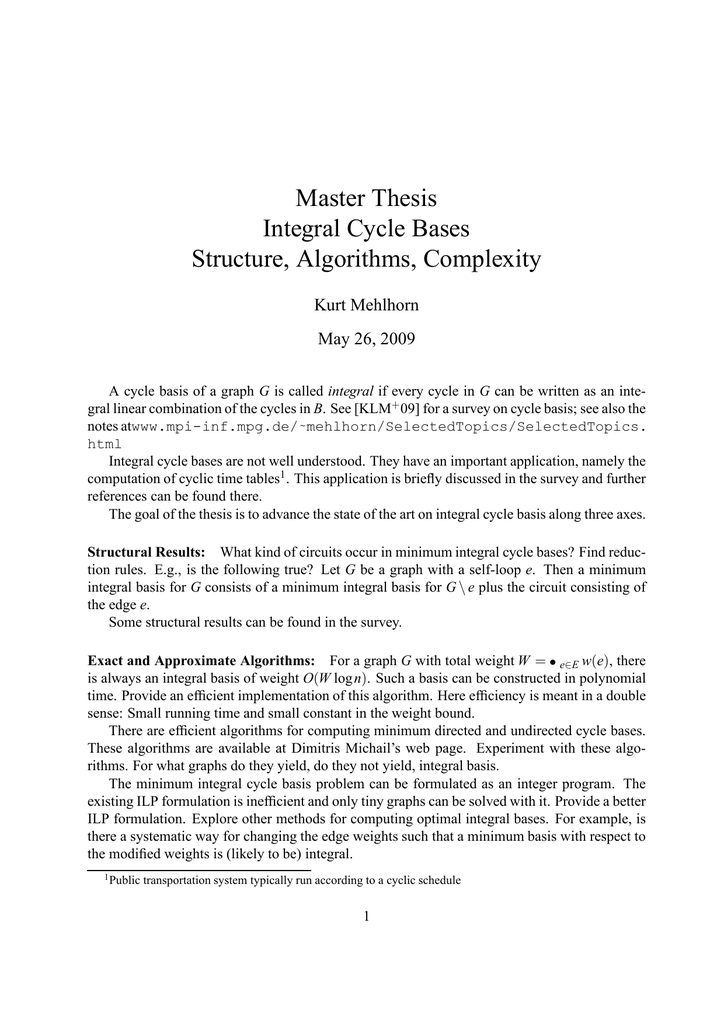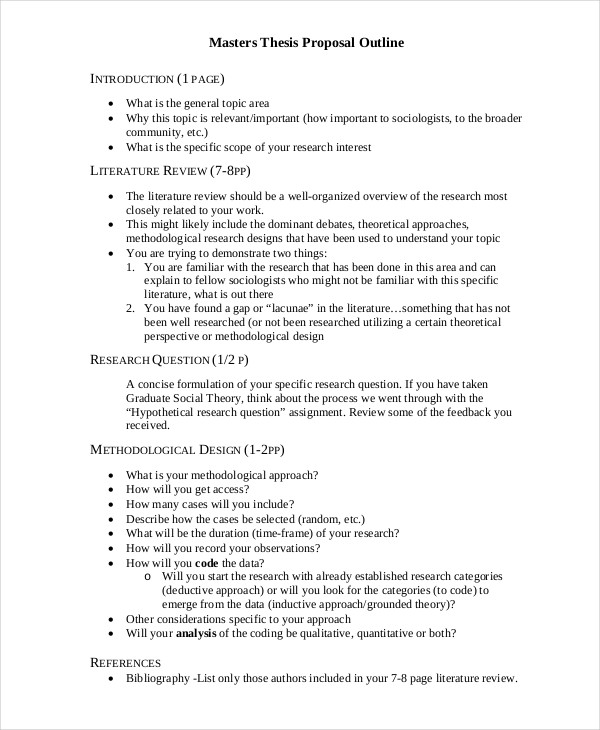
Advisory Committee. The completion of a Master’s Thesis constitutes six semester hours of credit. Master’s projects should be the result of work that is independently conducted, and that represents original research and critical analysis. The work should demonstrate the following from the student concerning the field of study Oct 02, · Format & Components of a Master's Thesis Introduction. As the first section a reader encounters after moving through the table of contents and other anterior Review of the literature. This section allows learners to demonstrate their deep knowledge of Estimated Reading Time: 11 mins Thesis for a Master of Philosophy Degree 5 Thesis for Taught Master Degree 6 CONTENTS 6 A. PRELIMINARY SECTION 7 1. Title Page 7 2. Intellectual Property Rights 7 3. Declaration of Authorship 7 4. Abstract 8 5. Table of Contents 8 6. List of Tables 8 7. List of Figures 8 8. List of Abbreviations 9 9. Prefatory Material 9 B. MAJOR COMPONENTS OF
Typical Structure of a Master Thesis - Professur für Modellierung räumlicher Mobilität
Research is a process which involves a lot of thinking, planning and writing. It is advisable to think about topics that interest you at the beginning of your program. You must also find a faculty member who can serve as your adviser and help you choose the committee members. In general, the first three chapters of your proposal are the Introduction, Literature Review and Methodology.
Take note of the following verb tenses when writing your chapters:. Present but mostly future. Your advisor is your ally. In order to obtain enough support from your advisor and your thesis committee members, you have to show that you have done your work well; therefore, you need to be prepared before a proposal meeting.
It can take several meetings before you are ready to defend your proposal, components of a masters thesis. Thesis research is directed research. Your advisor must give you advice, and you must do the work. When your proposal is approved, the process of operationalizing your method s to find answers to your questions begins. When it is finished, the process of rewriting the proposal can also start.
The first chapter of a proposal consists of several subheadings or sections: background, research questions, objectives, limitations, rationale, hypothesis optionalstatement of components of a masters thesis problem, and methodology. Discuss with your adviser as to which section should components of a masters thesis omitted or added. Subheadings and what they components of a masters thesis. When writing the remaining chapters of the thesis, the Limitation of the Study should be included in Chapter 3 as part of the Methodology.
Below are some suggested steps for writing the first chapter or Introduction. Think of topics that interest you. Discuss your topics with your adviser before choosing the most interesting and practical one. You have to search for more information first in order to understand what has been studied about the subject or your topic of interest.
Define a research problem. A pilot study or feasibility study can be done before the actual research process. Research questions should be developed keeping in mind time constraints—can these be answered by only one study or several studies?
Qualitative research starts an investigation with a concept. Quantitative research approaches use the hypothesis as the frame for the methodology. Here, you will have an appropriate framework and variables considered. In both approaches, the main research question is the basis for the hypotheses and objectives of the research. Hypotheses can be developed from the research questions. Designing a hypothesis is supported by a good research question and will influence the type of research design for the components of a masters thesis. The development of the research objective can be done after the development of the research questions or hypothesis.
This should be applied all throughout your paper. See Citations and References — The APA Style Guide for a guide to acknowledging the works of other authors when incorporating their ideas into your writing. The Literature Review. In this chapter and in the succeeding chapters of your thesis or dissertationyou need to write an introductory paragraph or paragraphs that show the following:, components of a masters thesis.
what the topic is about. the research or theoretical framework. reasons for reviewing the literature show the gap and how this research would fill that gap. what is discussed in the chapter, the order or sequence of the review.
what is included and not included in the chapter. The second part is the Body. The following are some elements that can be included in the second part of the Literature Review chapter. Discuss with your adviser to finalize the sections and sub-headings. a general view of the literature being reviewed to the specific focus of your research. the relationship between your chosen topic and the wider subject area; for instance, components of a masters thesis, between obesity in children and obesity in general; between perspectives of risks in communities and disaster resilience.
organization of the literature according to sub-topics or common themes:. historical background b. popular views vs. other views similar and contrasting views d. major questions presented e. general conclusions made by the authors. an in-depth examination of the literature in each sub-topic or theme presented 3.
The last part is the Chapter Summary. Summarize the important aspects of the existing body of literature. Assess the current state of the literature reviewed. This chapter presents your research design which describes and justifies the methods that will be used to collect your data.
It should be well-developed in order to obtain all the information required to answer your research questions, test a theory or explain a situation relevant to the main aim of the research. Start this chapter with a short introduction to your research design. In this section, the research questions, hypotheses and objectives must be presented.
An overview of the research approach, and the techniques and measurements that will be used to analyze data are also included in the introduction.
The next part of this chapter, or the Body, consists of some or all sections shown below. Each section should be described and explained in detail. Discuss with your adviser for additional sections and sub-headings for each section or a more appropriate structure. The last section is the Chapter Summary. The Final Chapters of your Thesis. At this stage, you have already collected as much data as you can and are ready to process and analyze such a huge amount of information. However, expect a lot of changes in your process, methods and chapters.
These changes can come from your research adviser, too. The first step you need to do is to revisit the first three chapters of your thesis.
Here, you would need to make the necessary corrections to some of the sections presented during the proposal stage. For example, you might have to fine-tune your research questions and objectives based on the data you have gathered or what you have found during the research process.
The Scope and Limitations of the Study section in Chapter 1 would now have to be included in Chapter 3, components of a masters thesis. Another section, Organization of the Study, must be added in Chapter 1. Check the figure below for the main parts of a thesis. Variations from the general format can be decided with your adviser.
Figure 1: Main parts of a thesis or dissertation. If this chapter is generally brief, presenting the results, and explaining and interpreting them can be combined in one chapter.
Otherwise, the Results and Discussion section should be in separate or defined sections or chapters. Start with a brief introduction of this chapter.
Results : answers to the research questions which are generated from the collected data. Your opinion should not be included when presenting the results. Descriptive or frequency statistical results of all variables must be reported first before specific statistical tests e. For instance, the profile of participants or respondents, components of a masters thesis, or characteristics of the sample is presented first if available. Specific quotes from interviews must be presented under a specific theme or sub-theme in the same way results from focus group discussions are reported.
When reporting results from observations, present the conversation, behavior or condition you have noticed first. Then, write your comments. Discussion : explains the meaning of the results presented in specific sections and links them to previous research studies. It explains why the findings are weak, strong or significant, and their limitations. A further review of the literature might be required to enhance the discussion of results, components of a masters thesis.
End each chapter with a summary. Introduce this chapter. First, refer back to the problem or topic that you have presented in Chapter 1 and what you hoped to achieve at the beginning of the research. The research questions you tried to answer must also be reviewed in this chapter as well as your hypotheses, if applicable. It is important to also reexamine the methodology followed in the research and show how the objectives were achieved or were not achieved with the application of different methods and techniques.
End this chapter with some reflections and final words. When all the chapters have been finalized, you are now ready to prepare the abstract.
It is written in the form of a summary, describing briefly the research problem, the aims of the research, the methods used to achieve them, and the main findings and conclusions. Although the abstract is very short approximately paragraphsit can be considered as the most significant part of your thesis or dissertation, components of a masters thesis.
The abstract provides a general impression of what your research is about, and allows other researchers to have components of a masters thesis broad understanding of your work.
Elements and Structure of a Master Thesis
, time: 14:19Main components of a master’s thesis or dissertation – Asian Institute of Technology

Oct 02, · Format & Components of a Master's Thesis Introduction. As the first section a reader encounters after moving through the table of contents and other anterior Review of the literature. This section allows learners to demonstrate their deep knowledge of Estimated Reading Time: 11 mins Components Of A Masters Thesis secure payment system. The support team will view it after the order form and payment is complete and then they will find Components Of A Masters Thesis an academic writer who matches your order description perfectly. Once you submit your instructions, while your order is in progress and even after its completion, our support Components Of A Masters Thesis team will /10() Advisory Committee. The completion of a Master’s Thesis constitutes six semester hours of credit. Master’s projects should be the result of work that is independently conducted, and that represents original research and critical analysis. The work should demonstrate the following from the student concerning the field of study

No comments:
Post a Comment